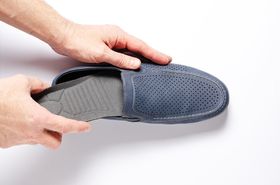Upstep Answers
Our team answers your questions about the causes and treatment of various podiatric conditions, including plantar fasciitis, flat feet, foot pain, and the use of custom orthotics.
Recent Answers
Shin Splints and Knee Pain: Is There a Connection?
Shin splints describe various conditions causing pain and discomfort in the front part of the tibia (shinbone), resulting from the overuse of the surrounding muscles and tendons, and should only cause
Asked 2 years ago
Should You Use Hard or Soft Orthotics for Plantar Fasciitis?
Walking with plantar fasciitis is painful. Thankfully, orthotics can often be used to help address the pain. Research has shown that orthotics can improve function and relieve pain in adults with acut
Asked 2 years ago
Should I Wear Orthotics All the Time?
Custom orthotics are designed specifically for your feet and intended to restore them to their ideal condition. There is no such thing as wearing them too much, but at some point, your podiatrist may
Asked 2 years ago
Do You Need Bigger Shoes to Wear Insoles?
Insoles are used by many people globally to provide comfort to the feet, relieve symptoms from various conditions that affect the feet, and prevent injuries from occurring. Insoles can be custom-made
Asked 2 years ago
How to Choose the Best Insoles for Overweight People
Being overweight can lead to increased pressure on the feet and may eventually lead to complications like bunions, flat feet, heel pain, and plantar fasciitis. You can protect and support the feet wit
Asked 2 years ago
Related Articles

Rigid vs. Soft Orthotics for Flat Feet, Plantar Fasciitis, and More
Janik Sundstrom
September 16, 2024

A PT’s Opinion on the Best Footwear and Insoles for Flat Feet
Babafemi Adebajo
May 14, 2025

Heel Spur Inserts—What Is Right for You?
Babafemi Adebajo
May 19, 2023

Best Orthotics For Dress Shoes
Janik Sundstrom
May 14, 2025

Are Birkenstocks Really Good for All Feet? A Podiatrist's Review
Janik Sundstrom
July 10, 2025
Recent Posts
Babafemi Adebajo
Persistent Shin Splints: Why Won’t They Go Away?
Babafemi Adebajo
Vitamins for Shin Splints: Choose the Right Supplements
Babafemi Adebajo
7 Best Orthotics to Aid With Your Lower Back Pain
Babafemi Adebajo
Best Insoles for Plantar Fibroma
Babafemi Adebajo
Out-Toeing—Symptoms, Causes, and Treatments
Janik Sundstrom
The Benefits of Taping for Cuboid Syndrome Treatment
Janik Sundstrom
5 Effective Home Remedies for Burning Feet Syndrome
Babafemi Adebajo



